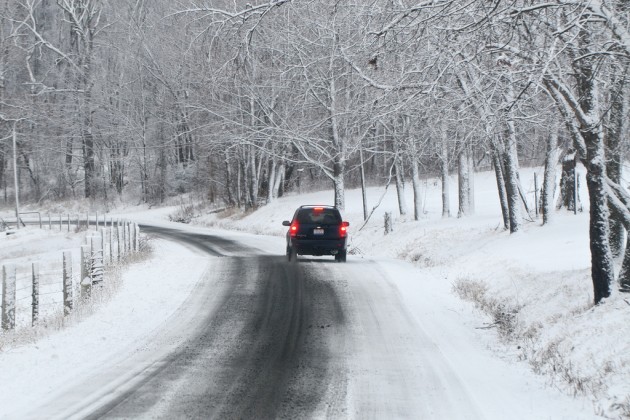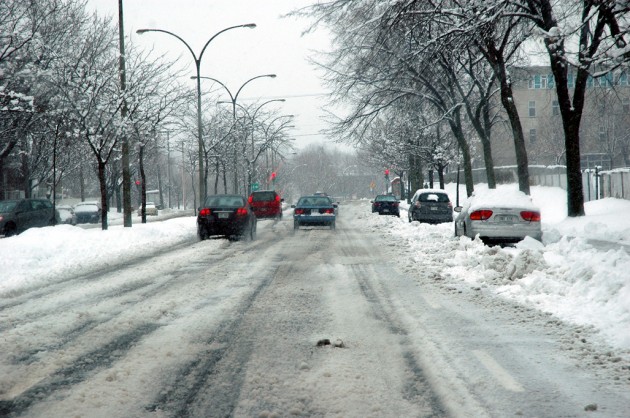Winter Driving Myths: What Should You Really Do in the Snow?
With winter right around the corner, there’s sure to be a flood of winter driving tips. The question is: how do you know which ones are right? If you don’t want to be crashing through the snow into a one-horse open sleigh, read on to discover debunked winter driving myths.
Related: What you should know to keep your car running during winter
1. Winter Driving Myths: Pumping the Brakes
Odds are if you’ve heard this tip it’s from someone a bit older. Also called pattern or cadence braking, this involves quickly pressing and releasing the brakes to avoid locking them up, and it works well – assuming you don’t have ABS. No, ABS is not the six-pack you had before the holidays turned it to mush – ABS stands for anti-lock braking system.
Most cars come standard with ABS now, which is your best friend in the snow. Anti-lock systems “pump” the brakes for you; it’s just so fast you can’t see it. You want to avoid pattern braking if you have ABS because it will actually make it harder to stop.
How do you know if you have ABS? Many cars come with it stamped somewhere on the steering wheel or dash. If you can’t find it, consult your car manual. Odds are, if you model was made after 2000, you’re good.
2. Winter Driving Myths: Starting in a Low Gear
If you start in low gear (or that little “1” you never seem to use) you’ll go slower, right? That’s only half-right. In reality, by shifting into that low-gear it means the engine will transfer more torque to the wheels, which isn’t ideal for winter driving. If you’re on ice and snow your wheels will probably spin, and you’ll get a whiff of that burnt rubber smell some car enthusiasts love.
Some companies, like Mercedes, offer winter-driving settings which actually start drivers off in a higher gear. This lowers the twisting motion of torque and prevents you from transferring your tire to the road.

You don’t want to get stuck out here because of winter driving myths you’ve heard
Photo:Susy Morris via CC
3. Winter Driving Myths: Put Weight in the Back of Your Car
This is another tip that only applies to some people. The purpose of this is to add weight on the axle which provides power; therefore, it really only applies to people with front-engine, rear-wheel drive (RWD) cars.
This tip is actually related to traction: if there’s weight on the axle and tires which spin, the car can grip better. Many cars on the market today are front-wheel drive or all-wheel drive (AWD), so putting sandbags in the back of these won’t do much besides lower your fuel economy. Check your manual or ask a mechanic if you’re unsure about your car.
For you oddballs with rear-engine RWD cars (remember the VW Transporter?), all the weight of the engine is already on the axle, so you’re good. Plus, you should be used bad handling and oversteer, so you’re especially prepared for winter.
Some experts argue if you have an advanced traction control system, adding weight is unnecessary, regardless. This can be true especially if you have new or seasonal tires for added grip. Then again, having a spare bag of salt or kitty litter might be useful if you’re stuck.
4. Winter Driving Myths: You’re Always Safer with AWD
While an AWD system can be great for accelerating on ice, it doesn’t necessarily mean you’re safer. Some advanced systems can transfer power to each individual tire as it is needed, which is a great driving aid, but it doesn’t negate the fact that you’re not stopping any quicker or handling much better. Quick acceleration in snow definitely has its downsides.
Unless you’re driving an ex-Soviet tank through Siberia (and no, a Hummer in Detroit isn’t the same), simply driving slow is your best bet. AWD is good for seasonal driving, but only if you don’t get overconfident and forget the fundamentals: go slow, be steady, and be alert.
Related: Sledding is almost as fun as driving, but you need to know these things to avoid injury
Sebastian is currently a graduate student living in Dayton with his lovely wife and crazy cat. He’s worked on a range of things in the past, from travel brochures to local politics. He’s ruined almost every car he’s had by taking them on road trips, but that doesn’t stop him from planning new ones. He reads excessively in his free time and is a nerd for classic movies and good beer.


